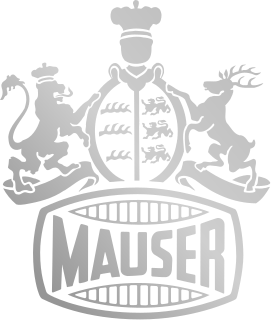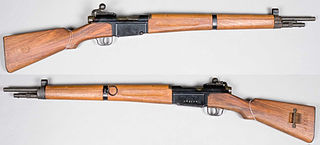
The Krag–Jørgensen is a repeating bolt action rifle designed by the Norwegians Ole Herman Johannes Krag and Erik Jørgensen in the late 19th century. It was adopted as a standard arm by Norway, Denmark, and the United States. About 300 were delivered to Boer forces of the South African Republic.

The Karabiner 98 kurz, often abbreviated Karabiner 98k, Kar98k or K98k and also incorrectly sometimes referred to as a K98, is a bolt-action rifle chambered for the 7.92×57mm Mauser cartridge. It was adopted on 21 June 1935 as the standard service rifle by the German Wehrmacht. It was one of the final developments in the long line of Mauser military rifles.

The FG 42 is a selective-fire 7.92×57mm Mauser automatic rifle produced in Nazi Germany during World War II. The weapon was developed specifically for the use of the Fallschirmjäger airborne infantry in 1942 and was used in very limited numbers until the end of the war.

Mauser, originally Königliche Waffen Schmieden, is a German arms manufacturer. Their line of bolt-action rifles and semi-automatic pistols has been produced since the 1870s for the German armed forces. In the late 19th and early 20th centuries, Mauser designs were also exported and licensed to many countries which adopted them as military and civilian sporting firearms. The Mauser Model 98 in particular was widely adopted and copied, and is the foundation of many of today's sporting bolt action rifles.

The M1903 Springfield, officially the United States Rifle, Caliber .30-06, Model 1903, is an American five-round magazine fed, bolt action service repeating rifle, used primarily during the first half of the 20th century.

The 7×57mm Mauser is a first-generation smokeless powder rimless bottlenecked rifle cartridge. It is known as .275 Rigby in the United Kingdom. It was developed by Paul Mauser of the Mauser company in 1892 and adopted as a military cartridge by Spain in 1893. It was subsequently adopted by several other countries as the standard military cartridge, and although now obsolete as a military cartridge, it remains in widespread international use as a sporting round. Many sporting rifles in this calibre were made by British riflemakers, among whom John Rigby was prominent; and, catering for the British preference for calibres to be designated in inches, Rigby called this chambering the .275 bore after the measurement of a 7 mm rifle's bore across the lands.

The MAS Modèle 36 is a military bolt-action rifle. First adopted in 1936 by France and intended to replace the Berthier and Lebel series of service rifles, it saw service long past the World War II period. It was manufactured from late 1937 onward by Manufacture d'Armes de Saint-Étienne (MAS), one of several government-owned arms factories in France. Only 250,000 MAS-36 rifles were available to equip the French infantry during the Battle of France in 1940. Mass production finally caught up after World War II and MAS-36 rifles became widely used in service during the First Indochina War, the Algerian War and the Suez Crisis. Altogether, about 1.1 million MAS-36 rifles had been manufactured when production ceased in 1952.

The Gewehr 98 is a German bolt action rifle made by Mauser firing cartridges from a 5-round internal clip-loaded magazine. It was the German service rifle from 1898 to 1935, when it was replaced by the Karabiner 98k, a shorter weapon using the same basic design. The Gewehr 98 action, using a stripper clip loaded with the 7.92×57mm Mauser cartridge, successfully combined and improved several bolt action engineering concepts which were soon adopted by many other countries including the UK, Japan, and the US. The Gewehr 98 replaced the earlier Gewehr 1888 as the main German service rifle. It first saw combat in the Chinese Boxer Rebellion and was the main German infantry service rifle of World War I. The Gewehr 98 saw further military use by the Ottoman Empire and Nationalist Spain.
The Model 98a carbine was a Polish derivative of the German Gewehr 98 bolt-action rifle.

The Karabinek wz.29 was a Polish bolt-action short rifle based on the German Kar98AZ. Identifying attributes include a 98/05 style mast bayonet lug ending directly beneath the front sight and winged protective ears to either side of the front sight blade. Cavalry models featured a turned-down bolt handle, and early versions had a stacking hook near the end of the stock on the right side.

The M1917 Enfield, the "American Enfield", formally named "United States Rifle, cal .30, Model of 1917" is an American modification and production of the .303-inch Pattern 1914 Enfield (P14) rifle, which was developed and manufactured during the period 1917–1918. Numerically, it was the main rifle used by the American Expeditionary Forces in Europe during World War I. The Danish Sirius Dog Sled Patrol on Greenland still use the M1917, which performs reliably in Arctic conditions, as their service weapon.
The puška vz. 33 was a Czechoslovak bolt-action carbine that was based on a Mauser-type action, designed and produced in Československá zbrojovka in Brno during the 1930s in order to replace the obsolete Mannlicher vz. 1895 carbines of the Czechoslovak četnictvo (gendarmerie). The manufacturer's designation was vz. 16/33. Another version, the Vz. 12/33, was also produced for the Latin American market.

"Swedish Mausers" are a family of bolt-action rifles based on an improved variant of Mauser's earlier Model 1893, but using the 6.5×55mm cartridge, and incorporating unique design elements as requested by Sweden. These are the m/94 carbine, m/96 long rifle, m/38 short rifle and m/41 sniper rifle. In 1898 production began at Carl Gustafs stads Gevärsfaktori in Eskilstuna, Sweden.
The evolution of German military rifles is a history of common and diverse paths followed by the separate German states, until the mid-19th century when Prussia emerged as the dominant state within Germany and the nation was unified. This article discusses rifled shoulder arms developed in or for the military of the states that later became Germany; it excludes firearms of the Austrian Empire, except where they were used substantially by German troops.
The Mauser Model 1893 is a bolt-action rifle commonly referred to as the Spanish Mauser, though the model was adopted by other countries in other calibers, most notably the Ottoman Empire. The M1893 was based on the experimental M1892 rifle, which Paul Mauser developed for the Spanish Army as part of a program to correct deficiencies in the earlier 1889, 1890, and 1891 series of Mauser rifles. The M1893 introduced a short staggered-column box magazine that fit flush with the bottom of the stock; the magazine held five smokeless 7×57mm Mauser rounds, which could be reloaded quickly by pushing a stripper clip from the top of the open bolt.

The Mauser Model 1889 is a bolt-action rifle of Belgian origin. It became known as the 1889 Belgian Mauser, 1891 Argentine Mauser, and 1890 Turkish Mauser.

The Mauser Model 1895 is a bolt operated magazine fed rifle using the 7×57mm Mauser cartridge. It was exported to many overseas powers, including the Chilean forces which adopted as the Fusil Mauser Chileno Mo 1895. It is the first major modification of the Mauser Model 1893 and was produced by Deutsche Waffen und Munitionsfabriken, known as DWM, and Ludwig Loewe Company from 1895 to 1900.
The Mauser Model 1904 and Model 1907 were Gewehr 98 pattern bolt-action battle rifles produced by Mauser and Deutsche Waffen und Munitionsfabriken (DWM). They were designed for export market. Copies were later produced in China and in Spain.
The Standardmodell rifle is a bolt-action rifle chambered for the 7.92×57mm Mauser cartridge that was developed in 1924 but entered full-scale production in 1933. Officially designed for export and German security guards, it was used by the paramilitary Sturmabteilung (SA) and Schutzstaffel (SS). Export variants were used in South America, Ethiopia, China and Iberian Peninsula. The carbine version of this rifle was almost identical with the Karabiner 98k that became the standard German service rifle during World War II.
The Steyr Model 1912 were Gewehr 98 pattern bolt-action battle rifles produced by Steyr before World War I. They were designed for export market. During the war, they were also used by the Austro-Hungarian Army.





















